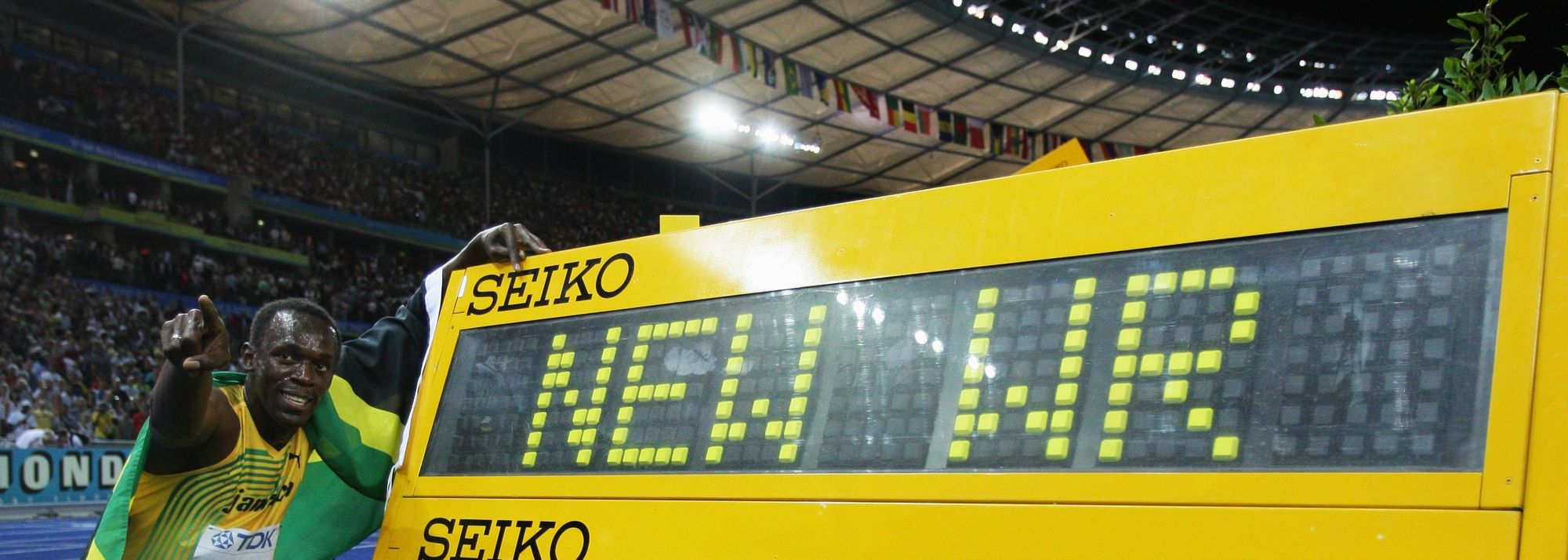Usain Bolt of Jamaica celebrates setting a world record while winning the 100m at the 12th IAAF World Athletics Championships (© Getty Images)
As time and distance define athletics, the role of long-standing IAAF partner Seiko in ensuring the validity and accuracy of both should not be underestimated.
Now in their 30th year of collaboration, the pair have undergone an “amazing journey” together in that time, overseeing many technological advances which has allowed for improved spectator experience, both inside the stadium and for the TV viewer.
During the past three decades, Seiko has been at the scene to record many of the IAAF World Championships’ iconic moments, including the sensational 8.95m long jump world record at the 1991 Tokyo edition and the breathtaking world record feats at the 2009 World Championships in Berlin.
They have always kept one step ahead of the great leaps forward taken by the athletes themselves, including the introduction of the ‘Seiko Start’ False Start System 20 years ago, which was quickly enhanced to include the electronic gun and auto recall systems.
Yet their core principles remain the same, according to Susan Boobyer, Events & Marketing Services Manager at SEIKO UK Limited.
“Our job is to support each and every competitor whether they come first or last in their event,” she explains. “These athletes are the best in the world and deserve the best services and support that we can provide, including fair, fast and accurate reading of their results.”
At the forthcoming IAAF World Championships to be staged in Beijing (Aug 22-30) Seiko’s technical team of about 60 experts will be on hand to ensure each and every performance is recorded accurately. With more than 60 per cent of the team located behind the scenes and not directly on the field of play – a figure that interestingly rises in percentage terms at each World Championships – Seiko plans some tweaks to their use of technology inside the Bird’s Nest Stadium.
The new field event boards that Seiko introduced in Moscow at the 2013 World Championships have been upgraded to create more interesting data and a more spectator friendly experience, according to Boobyer.
“This will involve backstage integration into the event presentation system, new staff and new software and hardware to control the flow of data,” he adds. “We hope that those in the stadium will be able to enjoy the amazing field event competitions even more by having key information presented at key moments.
“We are also planning to introduce the new trackside display boards, wind display board and lap display boards, which are all comprised with LED elements.”
As the world of athletics continues to move faster, Seiko will continue to fine tune some of their more recent innovations such as their video distance measurement system (VDM), which has revolutionised the way the horizontal jumps have been measured.
The system, which made its World Championship debut four years ago in Daegu, uses stereophonic cameras to capture the landing area for the long and triple jumps, which are calibrated in advance of the event. For each attempt, images are created and used to identify the precise landing point in the sand.
Seiko argues the process can accurately record distances within two millimetres and is a more precise system than EDM (electronic distance measurement), the one used prior to VDM, in which a spike or object was placed in the landing area which could lead to the displacement of sand.
Yet the system not only improves accuracy but also speed with the VDM taking seconds to be distributed.
“Our first priority must be accuracy,” says Boobyer. “Seiko’s VDM system, and with the chief judge sitting in the control room with the operator to verify each measurement, the results can be distributed within eight to ten seconds.”
Another area where Seiko can guarantee greater speed and accuracy is with their innovative slit video photo-finish system to determine those highly sought-after podium positions. Special high-definition cameras are set up to focus on the leading edge of the finish line and the whole viewing lens is blocked off apart from a thin slit that looks at the very first part of the white finish line.
This system is then triggered by an electronic start gun and as the athletes approach the finish, operators activate the camera to take up to 2000 images every second of the finish line.
According to Boobyer, this creates fast results but at no cost to accuracy.
“The Seiko photo-finish allows easy and quick reading of the photo-finish image – the chief judge verifies the results in the control room – and the results can be displayed in real-time on stadium scoreboards,” she adds. “If there’s a close finish then the judges will need to take longer to decide the final results, but in these cases the judges have in-field, out-field and head-on camera images to help them.”
Seiko’s transponder system – in which split times are recorded for every 100 metres of each race – will continue to be used, however, the hope is to be “cleverer” about the distribution and availability of such a large pool of data which the average spectator might find confusing but statisticians, broadcasters, coaches and the athletes themselves might find fascinating.
Whether poring over photo-finish data, its usage of the super accurate VDM system or innovative transponder system, you can guarantee that Seiko will continue to reliably and accurately log every run, jump and throw during nine days of thrilling action.
So what are their expectations for the 2015 IAAF World Championships in Beijing?
“A wonderful field of play for all athletes to compete at their very best, great global TV coverage and some world records would be nice,” she adds.
Steve Landells for the IAAF



